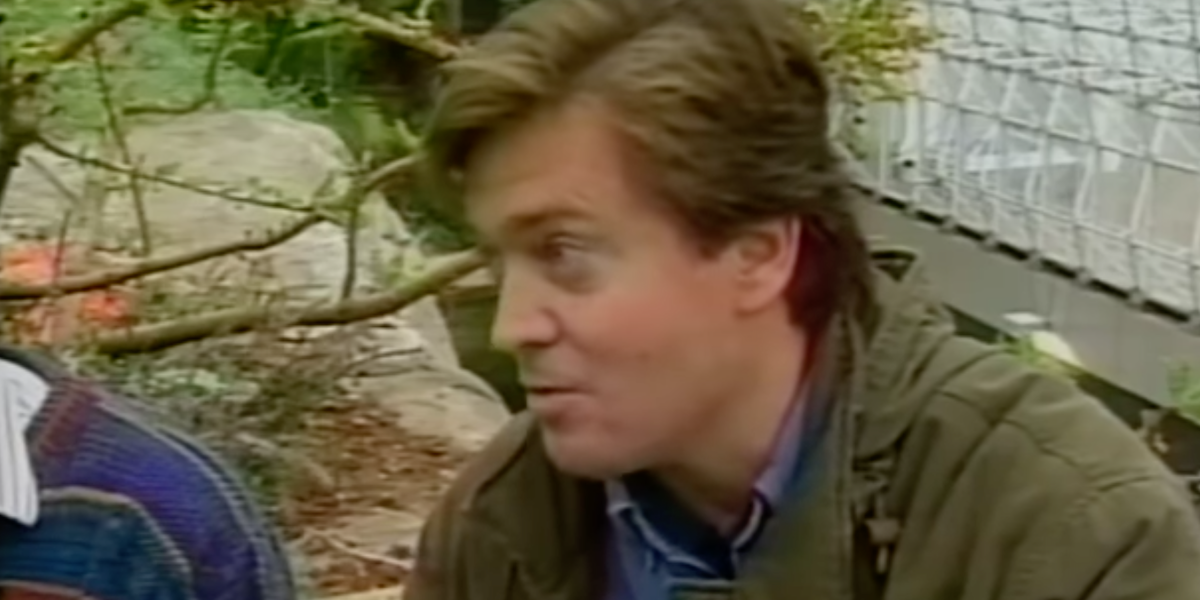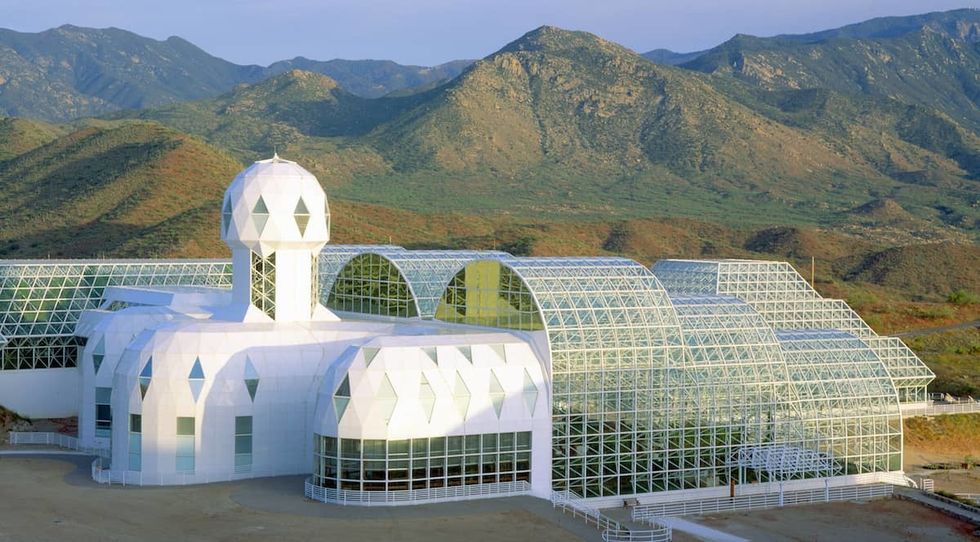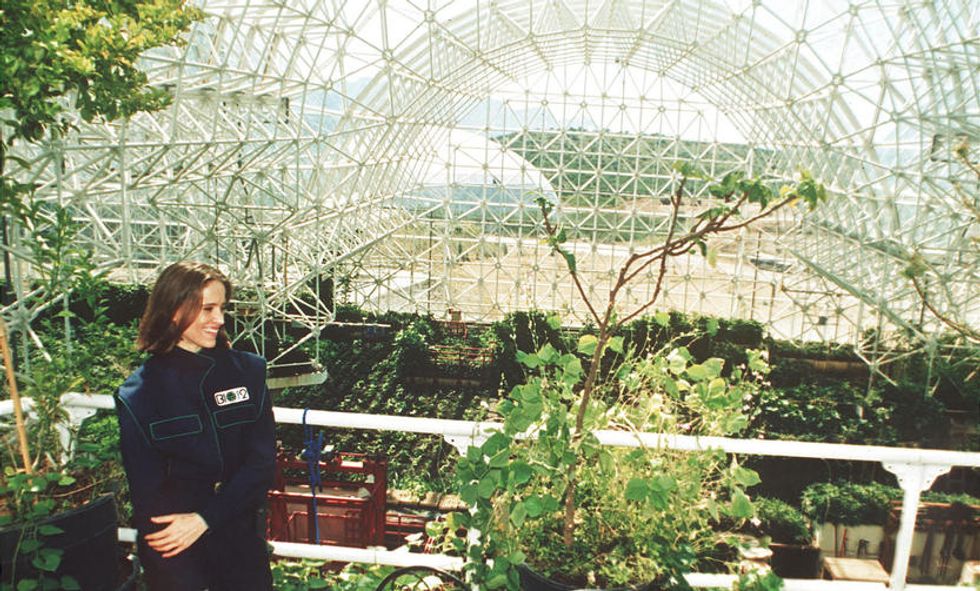CULTURE
When Steve Bannon Believed in Climate Change: “Spaceship Earth” Explores Isolation, Communes, and Armageddon
12 May, 20

Steve Bannon via YouTube.com
In 1991, eight people locked themselves in a gigantic biosphere in Arizona for two years. It was an experiment designed to see if humans could maintain the delicate balance needed for a self-sufficient existence.
The experiment succeeded, somewhat. Then its operations were abruptly ceded to Steve Bannon.
Behind the Biosphere
The documentary Spaceship Earth, released on Hulu this weekend, explores the heyday and fallout of the Biosphere 2 project. The Biosphere 2 was, in part, the brainchild of ecovillage called Synergia Ranch, it explains.
Founded by a man named John Allen, and inspired in part by the countercultural spirit of San Francisco the 1970s, Synergia was an artistic haven for hippies with a few differences—its members didn’t do drugs and instead focused on avant-garde theatrical productions, Buddhism, sustainable gardening, and scientific innovation. Eventually, the Synergia Ranch community began focusing on the environment, hosting conferences with scientists around the world. Out of these conferences, the idea for Biosphere 2 was born.
Spaceship Earth Trailer #1 (2020) | Movieclips Indiewww.youtube.com
Biosphere 2 was designed to be a completely self-sufficient environment, a test of whether humans could live within a contained system. With financial help from Synergia Ranch member Ed Bass, inheritor of an oil fortune who used his wealth to finance various environmental projects and wildlife research, Allen set ahead building the project and selecting the people who would spend two years inside of it.
Based in Oracle, Arazona, the biosphere ended up standing eight stories tall. It contained a miniature ocean and over 3000 species of plants. For a while, it was a major tourist attraction.
Now it’s gaining newfound attention, perhaps in part because of the similarities between its inhabitants’ confinement and some of our quarantine experiences.
Spaceship Earth, John Allen, and the Grand Biosphere Experiment
Featuring extensive interviews with members of Synergia Ranch and members of the Biosphere 2 project, the documentary focuses on Allen, painting him as a part-visionary, part-cult leader type of figure, who was able to develop a devoted following. Informed partly by mysticism, partly by an ability to read and access human emotions, Allen “preached the imminence of nuclear Armageddon and held that Western civilization had already collapsed,” according to a 1988 New York Times profile. He believed that “what was needed was a new civilization…based on a more enlightened relationship among man, machine and nature.”
He imagined that the biosphere project could eventually be used on other planets, or it could function as a safe house where people could survive on this planet, should life on the outside become unsustainable.
The biosphere also presented a viable commercial opportunity. “It’s a project that appealed to my interest in science and ecology,” Bass said in an interview. “I thought it had tremendous potential to develop technologies, know-how, data, and could have great use in environmental matters on all scales, from the fairly small to the planetary. And in a business sense, I saw that these technologies would have a very significant commercial application.”
The biosphere project’s eight inhabitants managed to survive for two years, though they did receive a bit of outside help—once, a participant left for surgery on a damaged hand and returned with some supplies, and once some extra oxygen was pumped into the ecosystem. But mostly, the eight managed to survive on food they grew from the biome’s ecosystem. There was some tension inside as oxygen levels began running low, but mostly, its inhabitants were focused on growing and harvesting and keeping their tiny world running.
Eventually, the eight emerged mostly victorious. They believed that the research from the project could be used to learn more about ecology and humanity’s relationship with the land, and many believed that it could redefine relationships between humans and the earth. But something had changed. All the bad press and “cult” accusations that the project received had made Bass nervous, and he fired Allen and hired… Steve Bannon, then a young leader fresh out of Goldman Sachs.
Steve Bannon and the Biosphere
Bannon was appointed CEO of the Biosphere project, and he set about making some changes. This was a long time before Bannon became a symbol of white nationalism and far-right misinformation as the founder of infamous far-right website Breitbart News. It was a long time before Bannon called climate change supporters “scum”; in fact, during his years as CEO, Bannon actually seemed acutely aware of climate change. In a 1995 interview for C-SPAN, he stated:
“A lot of the scientists who are studying global change and studying the effects of greenhouse gases, many of them feel that the Earth’s atmosphere in 100 years is what Biosphere 2’s atmosphere is today. We have extraordinarily high CO2, we have very high nitrous oxide, we have high methane. And we have lower oxygen content. So the power of this place is allowing those scientists who are really involved in the study of global change, and which, in the outside world or Biosphere 1, really have to work with just computer simulation, this actually allows them to study and monitor the impact of enhanced CO2 and other greenhouse gases on humans, plants, and animals.”
Yes, that’s Steve Bannon expressing fears about climate change, back when it was still a growing risk and not a cataclysmic reality.
Stephen Bannon Talks Biosphere 2www.youtube.com
Spaceship Earth doesn’t dive into Bannon’s involvement too deeply, choosing instead to focus on the project itself, but Bannon was a disastrous leader, to say the least. In 1993 he attempted to change the system’s primary management but was denied. He then quit but was later reinstated—but his leadership was so flawed that some of the experiment’s original members to stage a protest. They broke open windows, contaminating the experiment they’d spent two years creating. “In no way was it sabotage,” stated original participant Abigail Adams, who helped stage the insurrection. “It was my responsibility.”
During his tenure, Bannon was also accused of harassing employees and slandering female staff. The project director also accused him of slandering and sexual harassment, according to Vice and Buzzfeed News, but a counter-suit led her to drop the charges. Still, the company was required to pay hundreds of thousands of dollars in damages. Needless to say, the Biosphere experiment was not conducted again.
Examining the Biosphere’s Legacy: Climate Change, Cult Leaders, and Beyond
So how do we understand the Biosphere’s legacy today, in light of Bannon’s role? The experiment itself was written off as a failure. But it may have a lot to teach us right now, when our earth is in the midst of ecological collapse—particularly in light of the political challenges that currently stand in the way of humanity’s earthly survival.
The Biosphere experiment did show that humans and nature are deeply interconnected. It showed that carbon dioxide can be deadly, as an excess of C02 and a lack of oxygen nearly tanked the experiment before a little extra oxygen was poured in. It also highlighted the efficacy of our Earth’s aeration system—which has maintained perfectly livable oxygen levels for us for thousands of years—and emphasizes the dangers of the damage we’ve done.
But its story is also the story of the insidious role of big money and the fossil fuel industry in contributing to the climate crisis and in destroying efforts to stop it. Bannon and his ilk of fellow climate deniers pose massive, uniquely devastating threats to our global ecosystems, and Bannon seems to have destroyed an experiment that could’ve at least provided valuable scientific information to the wider world. He also learned nothing from it, having become a legendary opponent of climate change and the current administration, which has essentially destroyed decades of environmental progress in one fell swoop.
Why did Bannon decide to go back on what he knew about climate change? Why did all of the climate action that happened in the 70s and 80s suddenly stop? It certainly wasn’t because they didn’t know. The documentary mentions this insidious truth in passing, with interviewee Kathelin Gray stating, “The change is not because [Bannon] is not smart enough to see that there is climate change. He’s doing it for another reason.”
What is that reason? Most of the climate action of the 1980s was stymied by—what else—a complex collaboration between big oil and moneyed interests.
“The takeover of Bisophere 2 is what’s happening in the world now,” says another narrator. “Wall Street banker types, people just interested in short-term profit and loss, push out the innovators and destroy the world.”
In a world where fossil fuel companies still receive billions in bailout money while millions can’t feed their families, this is a lesson we’d do well to learn.
The Biosphere experiment wasn’t perfect. It was funded by a single wealthy donor and a man who many felt had cult leader-like power over his followers, and it was born out of the largely white upper-middle class California idealism that channeled Indigenous ideas about mutual reciprocity into an experiment in part designed to encourage the colonization of space.
If anything, Spaceship Earth is a cautionary tale and a window into just how wrong humanity’s attempts to control the world around him can go. It shows that if the world is to change, that change won’t come from a grand experiment or a single leader, be it John Allen or Steve Bannon. It’ll come from all of us, working together to give back to the planet that gives so much to us.















